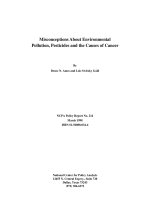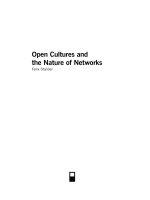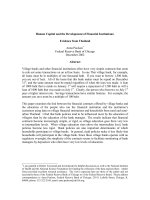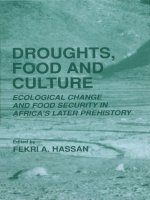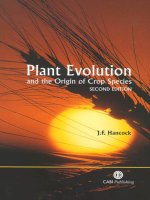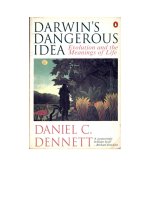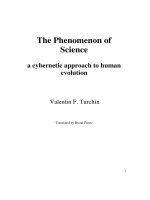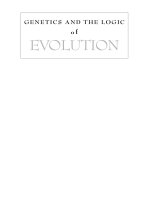Teaching About Evolution and the Nature of Science - NAP (2004) Episode 8 docx
Bạn đang xem bản rút gọn của tài liệu. Xem và tải ngay bản đầy đủ của tài liệu tại đây (192.34 KB, 15 trang )
Teaching About
Evolution and the Nature of Science
96
•
Zoological Philosophy
Jean Lamarck (1809)
The environment affects the shape and organi-
zation of animals, that is to say that when the
environment becomes very different, it produces
in course of time corresponding modifications in
the shape and organization of animals.
If a new environment, which has become per-
manent for some race of animals, induces new
habits in these animals, that is to say, leads them
into new activities which become habitual, the
result will be the use of some one part in prefer-
ence to some other part, and in some cases the
total disuse of some part no longer necessary.
Nothing of all this can be considered as
hypothesis or private opinion; on the contrary,
they are truths which, in order to be made clear,
only require attention and the observation of
facts.
Snakes have adopted the habit of crawling on
the ground and hiding in the grass; so that their
body, as a result of continually repeated efforts at
elongation for the purpose of passing through
narrow spaces, has acquired a considerable
length, quite out of proportion to its size. Now,
legs would have been quite useless to these ani-
mals and consequently unused. Long legs would
have interfered with their need of crawling, and
very short legs would have been incapable of
moving their body, since they could only have had
four. The disuse of these parts thus became per-
manent in the various races of these animals, and
resulted in the complete disappearance of these
same parts, although legs really belong to the plan
or organization of the animals of this class.
The frequent use of any organ, when con-
firmed by habit, increases the functions of that
organ, leads to its development, and endows it
with a size and power that it does not possess in
animals which exercise it less.
We have seen that the disuse of any organ
modifies, reduces, and finally extinguishes it.
I shall now prove that the constant use of any
organ, accompanied by efforts to get the most out
of it, strengthens and enlarges that organ, or cre-
ates new ones to carry on the functions that have
become necessary.
The bird which is drawn to the water by its
need of finding there the prey on which it lives,
separates the digits of its feet in trying to strike
the water and move about on the surface. The
skin which unites these digits at their base
acquires the habit of being stretched by these
continually repeated separations of the digits; thus
in course of time there are formed large webs
which unite the digits of ducks, geese, etc. as we
actually find them.
It is interesting to observe the result of habit
in the peculiar shape and size of the giraffe; this
animal, the largest of the mammals, is known to
live in the interior of Africa in places where the
soil is nearly always arid and barren, so that it is
obliged to browse on the leaves of trees and to
make constant efforts to reach them. From this
habit long maintained in all its race, it has result-
ed that the animal’s fore-legs have become longer
than its hind legs, and that its neck is lengthened
to such a degree that the giraffe, without standing
up on its hind legs, attains a height of six metres
(nearly twenty feet).
Philosophie Zoologique. Paris. 1809.
Translated by H. Elliott, Macmillan Company,
London. 1914.
Student Sheet
Copyright 2004 © National Academy of Sciences. All rights reserved.
Unless otherwise indicated, all materials in this PDF File provided by the National Academies Press (www.nap.edu) for research
purposes are copyrighted by the National Academy of Sciences. Distribution, posting, or copying is strictly prohibited without
written permission of the NAP.
Generated for on Sat Oct 9 17:18:26 2004
/>•
97
CHAPTER 6
Activities for Teaching About Evolution and the Nature of Science
On the Tendency of Varieties to
Depart Indefinitely from the
Original Type
Alfred Russel Wallace (1858)
The Struggle for Existence
The life of wild animals is a struggle for exis-
tence. The full exertion of all their faculties and all
their energies is required to preserve their own
existence and provide for that of their infant off-
spring. The possibility of procuring food during
the least favorable seasons and of escaping the
attacks of their most dangerous enemies are the
primary conditions which determine the existence
both of individuals and of entire species.
The numbers that die annually must be
immense; and as the individual existence of each
animal depends upon itself, those that die must be
the weakest—the very young, the aged, and the
diseased—while those that prolong their existence
can only be the most perfect in health and vigor,
those who are best able to obtain food regularly
and avoid their numerous enemies. It is “a struggle
for existence,” in which the weakest and least per-
fectly organized must always succumb.
Useful Variations Will Tend to Increase,
Unuseful or Hurtful Variations to Diminish
Most or perhaps all the variations from the typi-
cal form of a species must have some definite
effect, however slight, on the habits or capacities of
the individuals. Even a change of color might, by
rendering them more or less distinguishable, affect
their safety; a greater or less development of hair
might modify their habits. More important
changes, such as an increase in the power or
dimensions of the limbs or any of the external
organs, would more or less affect their mode of
procuring food or the range of country which they
could inhabit. It is also evident that most changes
would affect, either favorable or adversely, the
powers of prolonging existence. An antelope with
shorter or weaker legs must necessarily suffer more
from the attacks of the feline carnivora; the passen-
ger pigeon with less powerful wings would sooner
or later be affected in its powers of procuring a
regular supply of food; and in both cases the result
must necessarily be a diminution of the population
of the modified species.
If, on the other hand, any species should pro-
duce a variety having slightly increased powers of
preserving existence, that variety must inevitably in
time acquire a superiority in numbers.
Lamarck’s Hypothesis Very Different from that
Now Advanced
The hypothesis of Lamarck—that progressive
changes in species have been produced by the
attempts of animals to increase the development of
their own organs and thus modify their structure
and habits—has been repeatedly and easily refuted
by all writers on the subject of varieties and
species.
The giraffe did not acquire its long neck by
desiring to reach the foliage of the more lofty
shrubs and constantly stretching its neck for the
purpose, but because any varieties which occurred
among its ancestors with a longer neck than usual
at once secured a fresh range of pasture over the
same ground as their shorter-necked companions,
and on the first scarcity of food were thereby
enabled to outlive them.
Journal of the Proceedings of the Linnean Society
August 1858, London
Student Sheet
Copyright 2004 © National Academy of Sciences. All rights reserved.
Unless otherwise indicated, all materials in this PDF File provided by the National Academies Press (www.nap.edu) for research
purposes are copyrighted by the National Academy of Sciences. Distribution, posting, or copying is strictly prohibited without
written permission of the NAP.
Generated for on Sat Oct 9 17:18:26 2004
/>Teaching About
Evolution and the Nature of Science
98
•
On the Origin of Species
Charles Darwin (1859)
Introduction
When on board H.M.S. Beagle, as naturalist,
I was much struck with certain facts in the distri-
bution of the inhabitants of South America, and
in the geological relations of the present to the
past inhabitants of that continent. These facts
seemed to me to throw some light on the origin
of species—that mystery of mysteries, as it has
been called by one of our greatest philosophers.
On my return home, it occurred to me, in 1837,
that something might perhaps be made out on
this question by patiently accumulating and
reflecting on all sorts of facts which could possi-
bly have any bearing on it. After five years work
I allowed myself to speculate on the subject, and
drew up some short notes; these I enlarged in
1844 into a sketch of the conclusions, which then
seemed to me probable; from that period to the
present day I have steadily pursued the same
object. I hope that I may be excused for enter-
ing on these personal details, as I give them to
show that I have not been hasty in coming to a
decision.
My work is now nearly finished; but as it will
take me two or three more years to complete it,
and as my health is far from strong, I have been
urged to publish this Abstract. I have more espe-
cially been induced to do this, as Mr. Wallace,
who is now studying the natural history of the
Malay archipelago, has arrived at almost exactly
the same general conclusions that I have on the
origin of species. Last year he sent to me a mem-
oir on this subject, with a request that I would
forward it to Sir Charles Lyell, who sent it to the
Linnean Society, and it is published in the third
volume of the Journal of that Society. Sir C. Lyell
and Dr. Hooker, who both knew of my work—the
latter having read my sketch of 1844—honoured
me by thinking it advisable to publish, with Mr.
Wallace’s excellent memoir, some brief extracts
from my manuscripts.
In considering the Origin of Species, it is quite
conceivable that a naturalist, reflecting on the
mutual affinities of organic beings, on their
embryological relations, their geographical distri-
bution, geological succession, and other such
facts, might come to the conclusion that each
species had not been independently created, but
had descended, like varieties, from other species.
Nevertheless, such a conclusion, even if well
founded, would be unsatisfactory, until it could be
shown how the innumerable species inhabiting
this world have been modified, so as to acquire
that perfection of structure and coadaptation
which most justly excites our admiration.
Naturalists continually refer to external condi-
tions, such as climate, food, etc., as the only pos-
sible cause of variation. In one very limited
sense, as we shall hereafter see, this may be true;
but it is preposterous to attribute to mere exter-
nal conditions, the structure, for instance, of the
woodpecker, with its feet, tail, beak, and tongue,
so admirable adapted to catch insects under the
bark of trees. In the case of the misseltoe, which
draws its nourishment from certain trees, which
has seeds that must be transported by certain
birds, and which has flowers with separate sexes
absolutely requiring the agency of certain insects
to bring pollen from one flower to the other, it is
equally preposterous to account for the structure
of this parasite, with its relations to several dis-
tinct organic beings, by the effects of external
conditions, or of habit, or of the volition of the
plant itself.
The author of the ‘Vestiges of Creation’ would,
I presume, say that, after a certain unknown
number of generations, some bird had given birth
to a woodpecker, and some plant to the misseltoe,
and that these had been produced perfect as we
(Continued on page 99)
Student Sheet
Copyright 2004 © National Academy of Sciences. All rights reserved.
Unless otherwise indicated, all materials in this PDF File provided by the National Academies Press (www.nap.edu) for research
purposes are copyrighted by the National Academy of Sciences. Distribution, posting, or copying is strictly prohibited without
written permission of the NAP.
Generated for on Sat Oct 9 17:18:26 2004
/>•
99
CHAPTER 6
Activities for Teaching About Evolution and the Nature of Science
now see them; but this assumption seems to me
to be no explanation, for it leaves the case of the
coadaptations of organic beings to each other and
to their physical condition of life, untouched and
unexplained.
It is, therefore, of the highest importance to
gain a clear insight into the means of modifica-
tion and coadaptation. At the commencement of
my observations it seemed to me probable that a
careful study of domesticated animals and of cul-
tivated plants would offer the best chance of
making out this obscure problem. Nor have I
been disappointed; in this and in all other per-
plexing cases I have invariable found that our
knowledge, imperfect though it be, of variation
under domestication, afforded the best and safest
clue. I may venture to express my conviction of
the high value of such studies, although they have
been very commonly neglected by naturalists.
No one ought to feel surprise at much
remaining as yet unexplained in regard to the ori-
gin of species and varieties, if he makes due
allowance for our profound ignorance in regard
to the mutual relations of all the beings which
live around us. Who can explain why one species
ranges widely and is very numerous, and why
another allied species has a narrow range and is
rare? Yet these relations are of the highest
importance, for they determine the present wel-
fare, and, as I believe, the future success and
modification of every inhabitant of this world.
Still less do we know of the mutual relations of
the innumerable inhabitants of the world during
the many past geological epochs in its history.
Although much remains obscure, and will long
remain obscure, I can entertain no doubt, after
the most deliberate study and dispassionate judg-
ment of which I am capable, that the view which
most naturalists entertain, and which I formerly
entertained—namely, that each species has been
independently created—is erroneous. I am fully
convinced that species are not immutable; but
that those belonging to what are called the same
genera are lineal descendants of some other and
generally extinct species, in the same manner as
the acknowledged varieties of any one species are
the descendants of that species. Furthermore, I
am convinced that Natural Selection has been the
main but not exclusive means of modification.
On the Origin of Species by Means of Natural
Selection.
London. 1859.
(Continued from page 98)
Student Sheet
Copyright 2004 © National Academy of Sciences. All rights reserved.
Unless otherwise indicated, all materials in this PDF File provided by the National Academies Press (www.nap.edu) for research
purposes are copyrighted by the National Academy of Sciences. Distribution, posting, or copying is strictly prohibited without
written permission of the NAP.
Generated for on Sat Oct 9 17:18:26 2004
/>In this activity, students develop a model of the
mathematical nature of population growth. The
investigation provides an excellent opportunity for
consideration of the population growth of plant
and animal species and the resultant stresses that
contribute to natural selection. This activity will
require two class periods and is appropriate for
grades 5 through 12. The activity is based on an
original activity from the Earth Science Curricu-
lum Project. It is used with permission.
14
Standards-Based Outcomes
This activity provides all students an opportunity
to develop understandings about scientific inquiry
and biological evolution as described in the
National
Science Education Standards.
Specifically, it conveys
the following concepts:
• Mathematics is essential in scientific inquiry.
Mathematical tools and models guide and improve
the posing of questions, gathering data, construct-
ing explanations, and communicating results.
• Species evolve over time. Evolution is the
consequence of (1) the potential for a species to
increase its numbers, (2) the genetic variability of
offspring due to mutation and recombination of
genes, (3) a finite supply of the resources required
for life, and (4) the ensuing selection of those off-
spring better able to survive and leave offspring in
a particular environment. (Item 1 is the primary
content emphasis of this activity. Teachers can
introduce the other factors as appropriate.)
• Populations grow or decline through the
combined effects of births and deaths and through
emigration and immigration into specific areas.
Populations can increase through linear or expo-
nential growth, with effects on resource use and
on environmental pollution.
• Populations can reach limits to growth.
Carrying capacity is the maximum number of
organisms that can be supported by a given envi-
ronment.
• Living organisms have the capacity to pro-
duce populations of arbitrarily large size, but envi-
ronments and resources are finite. This funda-
mental tension has profound effects on the inter-
actions between organisms.
Science Background for Teachers
The tension between expanding populations
and limited resources was a fundamental point
that Darwin came to understand when he read
Thomas Malthus.
15
This understanding subse-
quently had an important influence on the formu-
lation of his theory of natural selection.
This activity extends the general idea of popu-
lation growth to humans. Here the important
point is that human beings live within the world’s
ecosystems. Increasingly, humans modify ecosys-
tems as a result of population growth, technology,
and consumption. Human destruction of habitats
through direct harvesting, pollution, atmospheric
changes, and other factors is threatening current
global stability, and, if not addressed, ecosystems
will be irreversibly affected.
The increase in the size of a population (such
as the human population) is an example of expo-
nential growth. The human population grew at
the slow rate of only about 0.002 percent a year
for the first several million years of our existence.
Since then the average annual rate of human pop-
ulation has increased to an all-time high of 2.06
percent in 1970. As the base number of people
undergoing growth has increased, it has taken less
and less time to add each new billion people. It
took 2 million years to add the first billion people;
130 years to add the second billion; 30 years to
add the third billion; 15 years to add the fourth
billion; and only 12 years to add the fifth billion.
We are now approaching the sixth billion.
Materials and Equipment
Each group of three or four students will need:
Teaching About
Evolution and the Nature of Science
100
•
ACTIVITY 8
Connecting Population Growth and
Biological Evolution
Copyright 2004 © National Academy of Sciences. All rights reserved.
Unless otherwise indicated, all materials in this PDF File provided by the National Academies Press (www.nap.edu) for research
purposes are copyrighted by the National Academy of Sciences. Distribution, posting, or copying is strictly prohibited without
written permission of the NAP.
Generated for on Sat Oct 9 17:18:26 2004
/>• Approximately 2,000 small, uniformly shaped
objects (kernels of corn, dried beans, wooden
markers, plastic beads)
• 10 paper cups or small beakers
• A 250-ml or 400-ml beaker
Instructional Strategy
Engage
Initiate a discussion on human popu-
lation with such questions as: How long have
humans been on the earth? How do you think the
early rate of human population growth compares
with the population growth rate today? Why did
this rate change?
Tell students that this investigation represents a
model of population growth rates.
Explore Have student groups complete the
following activities.
• Place the glass beakers on their desks. Begin
by placing two objects (e.g., corn or plastic beads)
in it. The beaker represents the limits of an
ecosystem or ultimately the earth.
• Place 10 cups in a row on their desk. In the
first cup, place two objects. In the second cup,
place twice as many objects as the first cup (four).
Have students record the number of objects on the
outside of the cup. Continue this procedure by
placing twice as many objects as in the former cup,
or doubling the number, in cups 3 through 10. Be
sure students record the numbers on the cups.
• Take the beaker and determine its height.
Have students indicate the approximate percent-
age of volume that is
without objects. Record this
on the table as 0 time.
• At timed intervals of 30 seconds, add the
contents of cups 1 through 10. Students should
record the total population and approximate per-
centage of volume in the beaker that is without
objects.
• Students should complete the procedure and
graph their results as total population versus
results.
Students may question the need for the 30-sec-
ond intervals. The length of the time interval is
arbitrary. Any time interval will do. Preparation
of the graph can be assigned as homework.
Range of Results
The mathematics involved in answering the
questions may challenge some students. Assist stu-
dents when necessary to enable them to accom-
plish the objectives of the investigation. Table 1
shows the population and the percent of the
beaker’s volume without objects. A typical student
graph is shown in Figure 1.
Explain Ask the students to explain the rela-
tionship between population growth and biological
evolution in populations of microorganisms, plants,
and animals. Through questions and discussion,
help them develop the connections stated in the
learning outcome for the activity. Evolution results
from an interaction of factors related to the poten-
tial for species to increase in numbers, the genetic
variability in a population, the supply of essential
resources, and environmental pressures for selec-
tion of those offspring that are able to survive and
reproduce.
Elaborate Begin by having students explain
the results of their activity. During the discussion
of the graph, have the students consider some of
the following: Are there any limitations to the
number of people the earth will support? Which
factor might limit population growth first? How
does this factor relate to human evolution? Are
•
101
CHAPTER 6
Activities for Teaching About Evolution and the Nature of Science
Time Population Percentage of empty
Internal volume (400-ml beaker)
0299%
1499%
2899%
316 98%
432 97%
564 95%
6 128 93%
7 256 88%
8 512 80%
9 1024 70%
10 2048 50%
11 4096 0%
Table 1
Population growth
Copyright 2004 © National Academy of Sciences. All rights reserved.
Unless otherwise indicated, all materials in this PDF File provided by the National Academies Press (www.nap.edu) for research
purposes are copyrighted by the National Academy of Sciences. Distribution, posting, or copying is strictly prohibited without
written permission of the NAP.
Generated for on Sat Oct 9 17:18:26 2004
/>there areas in the world where these limits have
been reached already? Have we gone beyond the
earth’s ideal population yet? What problems will
we face if we overpopulate the earth? How might
human influence on, for example, habitats affect
biological evolution. Students’ answers to these
questions will vary, depending on their background
and information. The outcome, however, should
be an intense discussion of some vital problems
and should provide opportunities to introduce the
fundamental concepts from the
National Science
Education Standards
.
Evaluation 1. Human population on the earth
is thought to have had a slow start, with doubling
periods as long as 1 million years. The current
world population is thought to be doubling every
37 years. How would this growth rate compare
with the rates found in your investigation?
Both the population in the investigation and on
the earth increase in a geometric progression.
This means the graphs have the same shape. You
can substitute 37 years for every 30-second inter-
val and the numbers will represent actual world
population growth. The slope of the graph would
remain the same.
2. What happens to populations when they
reach the limits to growth?
The populations stop growing because death rates
(or emigration) exceed birth rates (or immigration).
Teaching About
Evolution and the Nature of Science
102
•
4000
3000
2000
1000
500
250
01 234567891011
Population
Time 30-second intervals
Figure 1
Sample population growth graph
Copyright 2004 © National Academy of Sciences. All rights reserved.
Unless otherwise indicated, all materials in this PDF File provided by the National Academies Press (www.nap.edu) for research
purposes are copyrighted by the National Academy of Sciences. Distribution, posting, or copying is strictly prohibited without
written permission of the NAP.
Generated for on Sat Oct 9 17:18:26 2004
/>NOTES
1. National Research Council. 1996. National Science
Education Standards
. Washington, DC: National Academy
Press. www.nap.edu/readingroom/books/nses
2. A Draft Growth-of-Understanding Map derived from
Benchmarks for Science Literacy (Jan. 1998), AAAS
(American Association for the Advancement of Science)
Project 2061.
3. Biological Sciences Curriculum Study (BSCS). 1978.
Biology
Teachers’ Handbook
. 3rd ed. William V. Mayer, ed. New
York: John Wiley and Sons, pp. 350-352.
4.
Standards, p. 117.
5. Jonathan Weiner. 1994.
The Beak of the Finch:AStory of
Evolution in Our Time.
New York: Alfred A. Knopf.
6. Tijs Goldschmidt. 1996.
Darwin’s Dreampond: Drama in
Lake Victoria
. Cambridge, MA: MIT Press.
7.
BSCS Biology: A Human Approach. 1997. Dubuque, IA:
Kendall/Hunt Publishing Co., pp. 47-49 and pp. 64-69.
8. See Chapter 2 of this document for more discussion on
genetic variation and natural selection, and pages 158 and
185 of the
National Science Education Standards.
9.
Evolution: Inquiries into Biology and Earth Science by
BSCS
. 1992. Seattle: Videodiscovery, pp. 49-53 and pp.
211-221.
10.
Standards, p. 117.
11. Earth Science Curriculum Project (ESCP). 1973.
Investigating the Earth. rev. ed. Boston, MA: Houghton
Mifflin.
12. Please review pages 143-148 of the
National Science
Education Standards
.
13.
Investigating the Earth.
14.
Investigating the Earth.
15. Thomas Malthus. 1993.
Essay on the Principle of Population.
Geoffrey Gilbert, ed. Oxford: Oxford University Press.
•
103
CHAPTER 6
Activities for Teaching About Evolution and the Nature of Science
Copyright 2004 © National Academy of Sciences. All rights reserved.
Unless otherwise indicated, all materials in this PDF File provided by the National Academies Press (www.nap.edu) for research
purposes are copyrighted by the National Academy of Sciences. Distribution, posting, or copying is strictly prohibited without
written permission of the NAP.
Generated for on Sat Oct 9 17:18:26 2004
/>Copyright 2004 © National Academy of Sciences. All rights reserved.
Unless otherwise indicated, all materials in this PDF File provided by the National Academies Press (www.nap.edu) for research
purposes are copyrighted by the National Academy of Sciences. Distribution, posting, or copying is strictly prohibited without
written permission of the NAP.
Generated for on Sat Oct 9 17:18:26 2004
/>Q
uality instructional materials
are essential in teaching
about evolution and the
nature of science.
It also is important to consider
the context within which specific
materials will be used. This chapter
therefore begins with brief discussions of school
science programs and the criteria used to design
curricula.
Criteria for Contemporary
Science Curriculum
Before selecting specific materials to teach evo-
lution and the nature of science, it is important to
identify criteria that can help evaluate school sci-
ence programs and the design of instructional
materials. Chapter seven in the
National Science
Education Standards
, “Science Education Program
Standards,” describes the conditions needed for
quality school science programs. These conditions
focus on six areas:
• Consistency across all elements of the science
program and across the K-12 continuum
• Quality in the program of studies
• Coordination with mathematics
• Quality resources
• Equitable opportunities for achievement
• Collaboration within the school community to
support a quality program
Similarly, educators need to consider criteria
against which to judge instructional materials.
Teachers, curriculum designers, and
other school personnel can use the
following criteria to evaluate the
design of a new curriculum, to
select instructional materials, or to
adapt instructional materials
through professional development.
No set of instructional materials will meet all the
following criteria. You will have to make a judg-
ment about the degree to which materials meet
criteria and about acceptable and unacceptable
omissions. These criteria are adapted from earlier
discussions of standards-based curriculum.
1
Criterion 1: A Coherent, Consistent, and
Coordinated Framework for Science Content.
Science content should be consistent with national,
state, and local standards and benchmarks.
Whether for lessons, units, or a complete elemen-
tary, middle, or high school program, the content
should be well-thought-out, coordinated, and con-
ceptually, procedurally, and coherently organized.
The roles of science concepts, inquiry, science in
personal and social contexts, and the history and
nature of science should be clear and explicit.
Criterion 2: An Organized and Systematic
Approach to Instruction
. Most contemporary sci-
ence curricula incorporate an instructional model.
The instructional model should (1) provide for dif-
ferent forms of interaction among students and
between the teachers and students, (2) incorporate
a variety of teaching strategies, such as inquiry-ori-
ented investigations, cooperative groups, use of
technology, and (3) allow adequate time and
opportunities for students to acquire knowledge,
skills, and attitudes.
Selecting Instructional
Materials
7
•
105
•
Copyright 2004 © National Academy of Sciences. All rights reserved.
Unless otherwise indicated, all materials in this PDF File provided by the National Academies Press (www.nap.edu) for research
purposes are copyrighted by the National Academy of Sciences. Distribution, posting, or copying is strictly prohibited without
written permission of the NAP.
Generated for on Sat Oct 9 17:18:26 2004
/>Criterion 3: An Integration of Psychological
Principles Relative to Cognition, Motivation,
Development, and Social Psychology.
Psychological
principles such as those found in the American
Psychological Association publication
How Students
Learn: Reforming School Through Learner-
Centered Education
2
should be applied to the
framework for content, teaching, and assessment.
These psychological principles include more than
learning theory. They include providing for motiva-
tion, development, and social interactions.
Criterion 4: Varied Curriculum Emphases. The
idea of curriculum emphases can be expressed by
thinking about the foreground and background in a
painting. An artist decides what will be in the fore-
ground, and that subject is emphasized. Science
curricula can, for example, emphasize science con-
cepts, inquiry, or the history and nature of science,
while other goals may be evident but not empha-
sized. No one curriculum emphasis is best for all
students; probably, a variety of emphases accom-
modates the interests, strengths, and demands of
science content.
Criterion 5: An Array of Opportunities to
Develop Knowledge, Understanding, and Abilities
Associated with Different Dimensions of Scientific
Literacy.
Contemporary science curricula should
provide a balance among the different dimensions
of science literacy, which include an understanding
of scientific concepts, the ability to engage in
inquiry, and a capacity to apply scientific informa-
tion in making decisions.
3
Criterion 6: Teaching Methods and Assessment
Strategies Consistent with the Goal of Science
Literacy.
Approaches to teaching and assessment
ought to be consistent with the goals of teaching
evolution, inquiry, and the history and nature of
science. This can be accomplished by using
inquiry-oriented teaching methods and by assess-
ing students during investigative activities.
Criterion 7: Professional Development for
Science Teachers Who Implement the Curriculum.
Curricula need to provide opportunities that sup-
port teachers as they develop the knowledge and
skills associated with implementing and institution-
alizing the science program.
Criterion 8: An Inclusion of Appropriate
Educational Technologies.
The use of computers
and various types of software enhances learning
when students use the technologies in meaningful
ways. The use of educational technologies should
be consistent with other features of the curricu-
lum—for instance, the dimensions of scientific lit-
eracy and an instructional model.
Criterion 9: Thorough Field Testing and Review
for Scientific Accuracy and Pedagogic Quality.
One important legacy of the 1960s curriculum
reform is the field testing of materials in a variety of
science classrooms. Field testing and reviewing a
program identify problems that developers did not
recognize and fine tune the materials to the varied
needs of teachers, learners, and schools. Scientists
should review materials for accuracy. Developers
can miss the subtleties of scientific concepts,
inquiry, and design. In addition, educators who
review materials can provide valuable insights about
teaching and assessment that help developers
improve materials and enhance learning.
Criterion 10: Support from the Educational
System.
Research on the adoption, implementa-
tion, and change associated with curricula indicates
the importance of intellectual, financial, and moral
support from those within the larger educational
system.
4
This support includes science teachers,
administrators, school boards, and communities.
Although a curriculum cannot ensure support, it
should address the need for support and provide
indicators of support, such as provision of materials
and equipment for laboratory investigations, bud-
get allocations for professional development, and
proclamations by the school board.
Clearly, no one curriculum thoroughly incorpo-
rates all ten criteria. There are always trade-offs
when developing, adapting, or adopting a science
curriculum. However, the criteria should provide
assistance to those who have the responsibility of
improving the science curriculum.
Teaching About
Evolution and the Nature of Science
106
•
Copyright 2004 © National Academy of Sciences. All rights reserved.
Unless otherwise indicated, all materials in this PDF File provided by the National Academies Press (www.nap.edu) for research
purposes are copyrighted by the National Academy of Sciences. Distribution, posting, or copying is strictly prohibited without
written permission of the NAP.
Generated for on Sat Oct 9 17:18:26 2004
/>Analyzing Instructional
Materials
The process of selecting quality materials
includes determining the degree to which they are
consistent with the goals, principles, and criteria
developed in the
National Science Education
Standards
. Well-defined selection criteria help
ensure a thoughtful and effective process. To be
both usable and defensible, the selection criteria
must be few in number and embody the critical
tenets of accurate science content, effective teaching
strategies, and appropriate assessment techniques.
The process described in the following pages
can help teachers, curriculum designers, or other
school personnel complete a thorough and accu-
rate evaluation of instructional materials. To help
make this examination both thorough and usable,
references to specific pages and sections in the
National Science Education Standards have been
provided, as have worksheets to keep track of the
information needed to analyze and select the best
instructional materials.
Analysis Procedures
The procedures outlined in this section include:
• Overview of instructional materials
• Analysis of science subject matter
• Analysis of pedagogy
• Analysis of assessment process
• Evaluating the teacher’s guide
• Analysis of use and management
The extent to which instructional materials meet
the criteria outlined in this chapter determines
their usefulness for classroom teachers and the
degree of alignment with the
Standards. A thor-
ough analysis of instructional materials requires
considerable time and collaboration with others and
attention to detail. Good working notes are helpful
in this process. We recommend using the analysis
worksheets provided at the end of this chapter.
Overview of Instructional Materials
The following overview of instructional materi-
als introduces the review process and provides a
general context for analysis and subsequent selec-
tion of specific materials.
1. The first consideration is whether the key
concepts of evolution and the nature of science are
being emphasized. To help make this determina-
tion, locate the table of contents, index, and glos-
sary in the material you are evaluating. The box
below contains terms related to fundamental con-
cepts in evolution and the nature of science taken
from the
Standards. Record page numbers where
each is found for future reference. (See Worksheet
1 on page 112 in the back of this chapter.) These
terms will give you a preliminary indication of cov-
erage on these fundamental topics.
Evolution
evolution, diversity, adaptation, interpreting fossil
evidence, techniques for age determination,
natural selection, descent from common ancestors
Nature of Science
explanation, experiment, evidence, inquiry, model,
theory, skepticism
2. Look through both student and teacher
materials. Are student outcomes listed? Note
page numbers for several outcomes related to evo-
lution and the nature of science.
3. Look for student investigations or activities.
Where are they located? Note that in some mate-
rials, student investigations are integrated within
the reading material. In others they are located in
a separate section—sometimes at the back of a
chapter or book or in a separate laboratory manual.
4. Read several relevant paragraphs of student
text material. What is your judgment about the
concepts? Are the concepts in the students’ text
•
107
CHAPTER 7
Selecting Instructional Materials
Copyright 2004 © National Academy of Sciences. All rights reserved.
Unless otherwise indicated, all materials in this PDF File provided by the National Academies Press (www.nap.edu) for research
purposes are copyrighted by the National Academy of Sciences. Distribution, posting, or copying is strictly prohibited without
written permission of the NAP.
Generated for on Sat Oct 9 17:18:26 2004
/>consistent with the fundamental concepts in the
Standards? Does the text include more, fewer, or
different concepts?
5. Do the photographs and illustrations provide
further understanding of the fundamental concepts?
Analysis of Instructional Materials for
Science Subject Matter
A. CONTENT
The following procedures for content analysis
will help you examine instructional materials for
fundamental concepts of evolution, science as
inquiry, and the nature of science. Look for evi-
dence in discussions in the text and in the student
investigations to determine the degree to which
the fundamental concepts are addressed.
Fundamental concepts underlying specific stan-
dards on evolution and the nature of science are
referenced below. (Note: You will need a copy of
the
National Science Education Standards or
access to it through the World Wide Web at
www.nap.edu/readingroom/books/nses.)
Content Standard C—Life Science: grades 5-8,
“Diversity and Adaptations of Organisms,” p. 158;
grades 9-12, “Biological Evolution,” p. 185; also
read “Developing Student Understanding”
grades
5-8, pp. 155-156; and grades 9-12, p. 181.
Content Standard D—Earth and Space Science:
grades 5-8, “Earth’s History,” p. 160; grades 9-12,
“The Origin and Evolution of the Earth System,”
pp. 189-190; also read “Developing Student
Understanding,”
grades 5-8, pp. 158-159; grades 9-
12, pp. 187-188.
1. Choose a lesson or representative section of
the student instructional materials on the topic of
evolution. Make a preliminary list of the funda-
mental concepts from the Standards that are
included in the lesson and place them on your
worksheet. (See Worksheet 2 on page 114 in the
back of this chapter.)
2. Select one of these fundamental concepts
and list all sections of the materials that deal with
this idea. Determine whether the materials focus
on the fundamental concepts, or if they represent
only a superficial match. For example, Life Science
Standard C in the
Standards
5
specifies: “Biological
evolution accounts for the diversity of species
developed through gradual processes over many
generations. Species acquire many of their unique
characteristics through biological adaptation, which
involves the selection of naturally occurring varia-
tions in populations.” The instructional materials
should provide opportunities for students to devel-
op an understanding of biodiversity and evolution
as described in the
Standards. A negative example
would be defining the term biodiversity only in ref-
erence to the fact that wide varieties of plants and
animals populate particular environments.
You should complete this analysis for all funda-
mental concepts associated with a particular stan-
dard. The more fundamental concepts you analyze
using this process, the more confidence you will
have in the quality of the instructional materials
and their alignment with the
Standards. Identify
the fundamental concepts that are not developed
and the variation of treatment among those that
are included in the materials.
3. If appropriate, select one of the student
investigations for analysis of subject matter. On
what fundamental concepts from Life Science
Standard C or Earth and Space Science Standard
D is the investigation focused? To what degree
does the activity fulfill the intent of the fundamen-
tal concepts? For example, making and comparing
model casts and molds of sea shells does not neces-
sarily contribute to an understanding of how fossils
are formed or provide important evidence of how
life and environmental conditions have changed. It
is recommended that you analyze a second student
investigation.
B. SCIENTIFIC INQUIRY
1. You should develop some understanding of
scientific inquiry in the
Standards. Read Standard
A, Science as Inquiry, referenced on the following
page.
Teaching About
Evolution and the Nature of Science
108
•
Copyright 2004 © National Academy of Sciences. All rights reserved.
Unless otherwise indicated, all materials in this PDF File provided by the National Academies Press (www.nap.edu) for research
purposes are copyrighted by the National Academy of Sciences. Distribution, posting, or copying is strictly prohibited without
written permission of the NAP.
Generated for on Sat Oct 9 17:18:26 2004
/>Standard A—Science as Inquiry: grades 5-8, pp.
145-148;
grades 9-12, pp. 175-176; also read
“Developing Student Understanding,”
grades 5-8,
pp. 143-144; grades 9-12, pp. 173-174.
Note that Standard A specifies two separate
aspects of science as inquiry: abilities necessary to
do scientific inquiry, and fundamental understand-
ings about scientific inquiry. Examine several
lessons in the student and teacher materials to
answer the following question: To what degree do
the lessons provide students the opportunity to
develop the abilities and understandings of scien-
tific inquiry?
2. Read through the text narrative, looking for
student investigations and examining any sugges-
tions for activities outside of class time. Are oppor-
tunities provided for students to develop abilities
of scientific inquiry such as posing their own rele-
vant questions, planning and conducting investiga-
tions, using appropriate tools and techniques to
gather data, using evidence to communicate defen-
sible explanations of cause and effect relationships,
or using scientific criteria to analyze alternative
explanations to determine a preferred explanation?
Record page numbers where examples are found
and make notes of explanation.
2. What opportunities are provided for students
to develop a fundamental understanding of scientif-
ic inquiry? In addition to the language of the text,
examine the teacher’s guide for suggestions that
teachers can use to discuss the role and limitations
of scientific skills such as making observations,
organizing and interpreting data, and constructing
defensible explanations based on evidence. Can
you find a discussion of how science advances
through legitimate skepticism? Can you find a dis-
cussion of how scientists evaluate proposed expla-
nations of others by examining and comparing evi-
dence, identifying reasoning that goes beyond the
evidence, and suggesting alternative explanations
for the same evidence? Are there opportunities for
students to demonstrate these same understandings
as a part of their investigations? Make notes where
this evidence is found for later reference.
C. HISTORY AND NATURE OF SCIENCE
1. Are history and the nature of science incor-
porated into the treatment of evolution? Read
Standard G, History and Nature of Science, refer-
enced in the following box.
Content Standard G—History and Nature of Science:
grades 5-8, pp. 170-171; grades 9-12, pp. 200-201
and p. 204; also read “Developing Student Under-
standing,” grades 5-8, p. 170; grades 9-12, p. 200.
2. Read through several lessons in the student
and teacher materials. Can you find examples
describing the roles of scientists, human insight,
and scientific reasoning in the historical and con-
temporary development of explanations for evolu-
tion? Can you find specific references to historical
contributions of scientists in the development of
fundamental concepts of evolution? What evi-
dence can you find in the text narrative or student
investigations that demonstrates how scientific
explanations are developed, reviewed by peers, and
revised in light of new evidence and thinking?
Analysis of Pedagogy
What students learn about evolution and the
nature of science depends on many things, includ-
ing the accuracy and developmental appropriate-
ness of content and its congruence with the full
intent of the content standards. Opportunities to
learn should be consistent with contemporary
models of learning. The criteria in this section are
based on characteristics of effective teaching pro-
posed in Teaching Standards A, B, and E.
Teaching Standard A—Teachers of science plan an
inquiry-based science program for their students,
pp. 30-32.
Teaching Standard B—Teachers of science guide
and facilitate learning, pp. 32-33 and 36-37.
Teaching Standard E—Teachers of science develop
communities of science learners that reflect the intel-
lectual rigor of scientific inquiry and the attitudes and
social values conducive to science learning, pp. 45-46
and 50-51.
•
109
CHAPTER 7
Selecting Instructional Materials
Copyright 2004 © National Academy of Sciences. All rights reserved.
Unless otherwise indicated, all materials in this PDF File provided by the National Academies Press (www.nap.edu) for research
purposes are copyrighted by the National Academy of Sciences. Distribution, posting, or copying is strictly prohibited without
written permission of the NAP.
Generated for on Sat Oct 9 17:18:26 2004
/>Using the following sequence of questions,
examine several lessons in the student materials
and the teacher’s guide. (See Worksheet 3 on page
117 in the back of this chapter.)
1. Do the materials identify specific learning
goals or outcomes for students that focus on one or
more of the fundamental concepts of evolution and
the nature of science?
2. Study the opening pages of a relevant chap-
ter or section. Does the material on the opening
pages of the chapter or section on evolution
engage and focus student thinking on interesting
questions, problems, or relevant issues?
3. Does the material provide a sequence of
learning activities connected in such a way as to
help students build understanding of a fundamen-
tal concept? Are suggestions provided to help the
teacher keep students focused on the purpose of
the lesson?
4. Does the teacher’s guide present common stu-
dent misconceptions related to the fundamental con-
cepts of evolution and the nature of science? Are
suggestions provided for teachers to find out what
their students already know? Are there learning
activities designed to help students confront their
misconceptions and encourage conceptual change?
Analysis of Assessment Process
Assessment criteria in this section are grounded
in the Assessment Standards.
Assessment Standards A to E, Chapter 5, pp. 78-
87.
Examine several lessons in the student and
teacher materials for evidence to answer the fol-
lowing questions. (See Worksheet 4 on page 118
in the back of this chapter.)
1. Is there consistency between learning goals
and assessment? For example, if instruction focuses
on building understanding of fundamental con-
cepts, do assessments focus on explanations and
not on vocabulary?
2. Do assessments stress application of concepts
to new or different situations? For example, are
the students asked to explain new situations with
concepts they have learned?
3. Are assessment tasks fair for all students?
For example, does success on assessment tasks
depend too heavily on the student’s ability to read
complex items or write explanations as opposed to
understanding the fundamental concepts?
4. Are suggestions for scoring criteria or rubrics
provided for the teacher?
Evaluating the Teacher’s Guide
Examine several lessons in the teacher’s guide
to help answer the following questions:
1. Does the teacher’s guide present appropriate
and sufficient background on science?
2. Are the suggested teaching strategies usable
by most teachers?
3. Are suggestions provided for pre- and post-
investigation discussions focusing on concept
development, inquiry, and the nature of science?
4. Does the teacher’s guide recommend addi-
tional professional development?
5. Does the teacher’s guide indicate the types of
support teachers will need for the instructional
materials?
Analysis of Use and Management
A high degree of alignment with Standards
content, pedagogy, and assessment criteria does
not necessarily guarantee that instructional materi-
als will be easy to manage. The
Standards address
the importance of professional development, and
some aspects of the program standards apply as
well.
6
1. How many different types of materials must
be managed and orchestrated during a typical
chapter, unit, or teaching sequence (e.g., student
text, teacher’s guide, transparencies, handouts,
Teaching About
Evolution and the Nature of Science
110
•
Copyright 2004 © National Academy of Sciences. All rights reserved.
Unless otherwise indicated, all materials in this PDF File provided by the National Academies Press (www.nap.edu) for research
purposes are copyrighted by the National Academy of Sciences. Distribution, posting, or copying is strictly prohibited without
written permission of the NAP.
Generated for on Sat Oct 9 17:18:26 2004
/>
